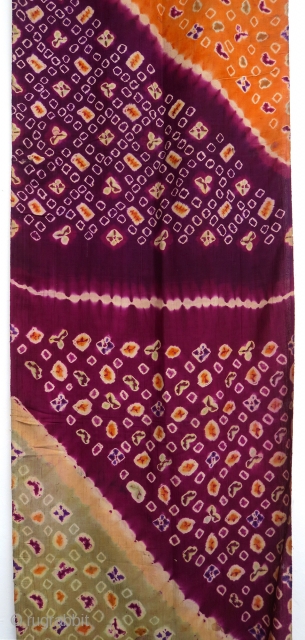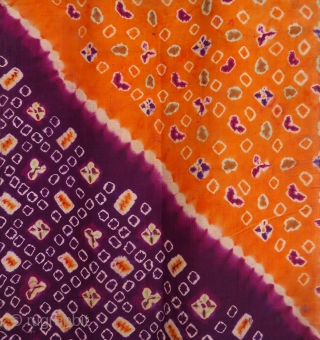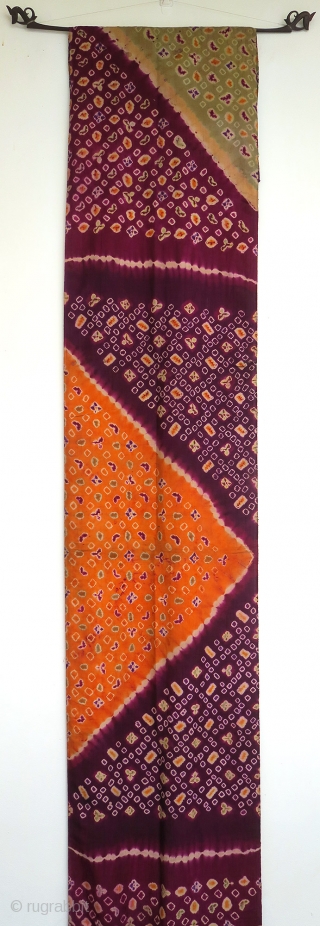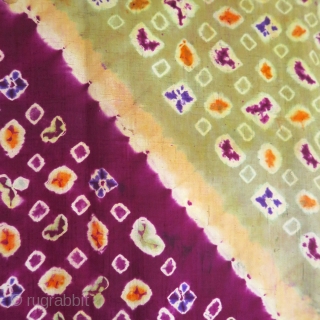Back
Bali | Tie-dye pelangi silk wrapper, early 20th century
Indonesia, Bali, Singaraja, early 20th century
Imported silk, aniline dyes, tie-dye (pelangi) and stitch-resist (tritik)
A stunning silk pelangi wrapper tie-dyed in Singaraja in north Bali. Its luxurious length of 3 metres is divided along the diagonal in a bold format of different coloured triangles in plum, grape purple, soft pistachio green and mandarin orange. The colours are marked off by broad lines of stitch-resist (tritik) that produces an irregular splodgy line; note that the green end sections have an inner border of pale honey that sets off these light triangles against the other vivid colours. Small coloured motifs of lozenges, curves, three- and four-petalled florets, outlined in white, alternate with open squares in a loosely arranged diagonal grid. The motifs are slightly varied across the sections; oblong orange motifs only appear in the purple sections, in a more geometric pattern. Balancing the bold design format and ground colours, the delicate pelangi technique creates shimmering, uneven definition of line and color, and an impression of scattered flowers emerging or floating in water. At each end a large-scale undulating tritik line separates solid plum and purple fields in a dramatic effect.
Context: The early entry of aniline dyes into Bali enhanced their spectacular mastery of colour and movement. The term pelangi means “rainbow” or “many-coloured” and denotes a type of (usually silk) textile decorated by the tie-dye technique of the same name, whereby the pattern is built up from binding small pockets of cloth so that they resist the dye. Pelangi, especially in silk, is an older type of Balinese textile for smaller pieces like shoulder cloths, sashes, upper-body wrappers and shrine coverings. It is always brightly-coloured and is used for rituals and ceremonial occasions. The brilliance of this textile has to be imagined as worn with other contrastive pieces wrapped around the body—only flat cloths (not sewn into garments or a tubeskirt) are permitted as ceremonial or ritual clothing. The format of triangular sections in different colours is uniquely Balinese.
The textile is in very good condition, with a few tiny holes that are barely visible unless held against the light, two small light stains and an old repaired 1" split, also hardly noticeable. The colours are glowing and surprisingly vivid; the silk is quite light, with a soft crepe-like texture and fluid drape.
306 x 42 cm.
Indonesia, Bali, Singaraja, early 20th century
Imported silk, aniline dyes, tie-dye (pelangi) and stitch-resist (tritik)
A stunning silk pelangi wrapper tie-dyed in Singaraja in north Bali. Its luxurious length of 3 metres is divided along the diagonal in a bold format of different coloured triangles in plum, grape purple, soft pistachio green and mandarin orange. The colours are marked off by broad lines of stitch-resist (tritik) that produces an irregular splodgy line; note that the green end sections have an inner border of pale honey that sets off these light triangles against the other vivid colours. Small coloured motifs of lozenges, curves, three- and four-petalled florets, outlined in white, alternate with open squares in a loosely arranged diagonal grid. The motifs are slightly varied across the sections; oblong orange motifs only appear in the purple sections, in a more geometric pattern. Balancing the bold design format and ground colours, the delicate pelangi technique creates shimmering, uneven definition of line and color, and an impression of scattered flowers emerging or floating in water. At each end a large-scale undulating tritik line separates solid plum and purple fields in a dramatic effect.
Context: The early entry of aniline dyes into Bali enhanced their spectacular mastery of colour and movement. The term pelangi means “rainbow” or “many-coloured” and denotes a type of (usually silk) textile decorated by the tie-dye technique of the same name, whereby the pattern is built up from binding small pockets of cloth so that they resist the dye. Pelangi, especially in silk, is an older type of Balinese textile for smaller pieces like shoulder cloths, sashes, upper-body wrappers and shrine coverings. It is always brightly-coloured and is used for rituals and ceremonial occasions. The brilliance of this textile has to be imagined as worn with other contrastive pieces wrapped around the body—only flat cloths (not sewn into garments or a tubeskirt) are permitted as ceremonial or ritual clothing. The format of triangular sections in different colours is uniquely Balinese.
The textile is in very good condition, with a few tiny holes that are barely visible unless held against the light, two small light stains and an old repaired 1" split, also hardly noticeable. The colours are glowing and surprisingly vivid; the silk is quite light, with a soft crepe-like texture and fluid drape.
306 x 42 cm.
price:
SOLD
- Home
- Antique Rugs by Region
- Category
- Profiles
- Post Items Free
- Albums
- Benaki Museum of Islamic Art
- Budapest: Ottoman Carpets
- Gulbenkian Museum
- Islamic Carpets. Brooklyn
- Islamic Textiles. Brooklyn
- Konya Museum: Rugs
- MKG, Hamburg
- MMA: Caucasian Carpets
- MMA: Mamluk Carpets
- MMA: Mughal Indian Carpets
- MMA: Ottoman Carpets
- MMA: Safavid Persian Carpets
- MMA: Turkmen Rugs
- McCoy Jones Kilims
- Ottoman textiles. Met
- Philadelphia Museum
- Rugs and Carpets: Berlin
- Seljuqs at the Met
- TIEM, Istanbul: Carpets
- V&A: Classical Carpets
- Vakiflar Carpets: Istanbul
- Baluch Rugs: Indianapolis
- Gallery Exhibitions
- Jaf an Exhibition
- Alberto Levi Gallery
- Andean Textile
- Christie's London: 2016
- Francesca Galloway
- HALI at 40
- ICOC Washington, DC 2018
- Jajims of the Shahsavan
- London Islamic Week April, 2018
- Mongolian Felts
- Navajo Rugs: JB Moore
- Persian Piled Weavings
- SF Tribal & Textile Art Show 2020
- SF Tribal 2019
- Sotheby's: C. Alexander
- Turkish Prayer Rugs
- Turkmen Main Carpets ICOC 2007















